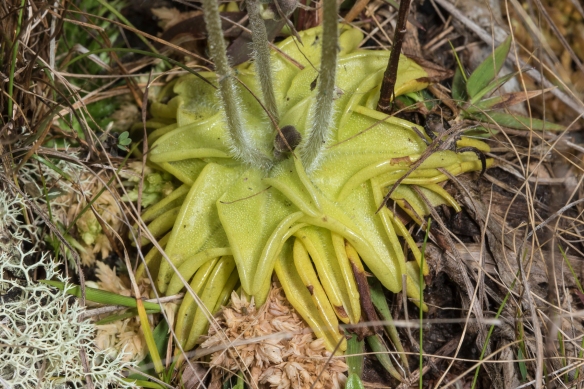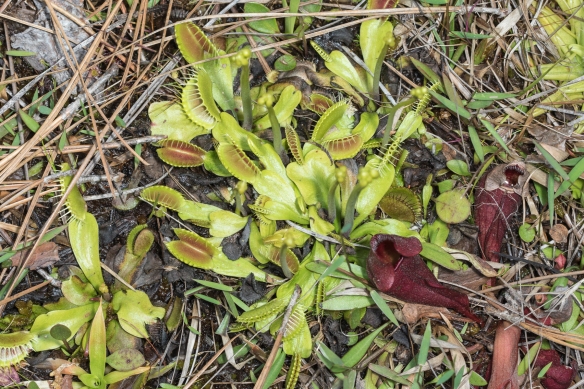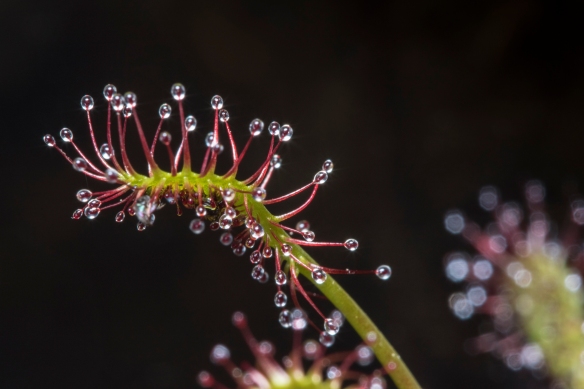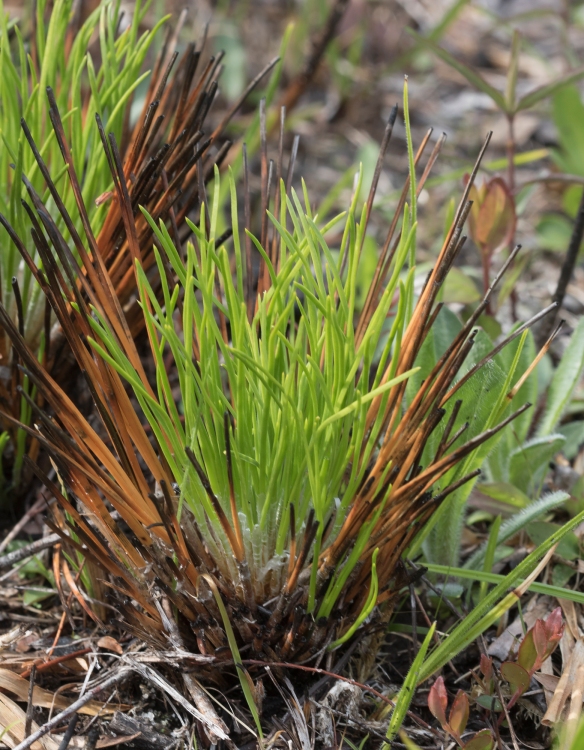There is no exquisite beauty …without some strangeness.
~Edgar Allan Poe
Part two of our quest for carnivorous plants took us first to the Green Swamp, a well-known NC Nature Conservancy preserve site in Brunswick and Columbus counties. It was getting late in the day, so we went straight to the main access point, a small parking area next to a borrow pit along Hwy 211. We hiked in along the trail, through a short stretch of dense pocosin vegetation, and out into the open longleaf pine savanna.

Longleaf pine savanna in the Green Swamp (click photos to enlarge)
What you find here often greatly depends on the fire regimen – the year after a burn can produce spectacular wildflowers and make it much easier to see any in bloom. From the looks of it, I am guessing it may have been over a year since this particular tract was burned, but we could see some scattered spots of color poking above the clumps of wiregrass, especially along the pocosin edge.

Grass pink orchid, Calopogon sp.
In addition to insect-eating plants, these pine savannas are well-known for their gorgeous orchids. Calopogon comes from the Greek words meaning beautiful beard, and refers to the bushy, yellow protuberances on the lip of this delicate orchid. These are designed to attract pollinators, thinking there might be a pollen or nectar reward, but it is a deception. The lip of the flower is hinged at the base, and when an insect lands, the lip drops and traps the insect among the flower parts, forcing it to wriggle its way out, and, in the process, hopefully pollinating the flower.

Yellow butterwort, Pinguicula lutea
Scattered along the edges of the savanna are small, bright yellow flowers of a carnivorous species, the yellow butterwort.

Basal rosette of a butterwort
The business end of a butterwort lies at the base, where a tight cluster of sticky leaves serves to trap small insects by means of tiny stalked glands covered in mucilage. Other glands release digestive enzymes to help dissolve the soft tissues of the prey, with the nutrient-rich juices being absorbed by the leaf to supplement its nitrogen supply in this nutrient-poor environment.

Pink sundew, Drosera capillaris
A similar, but more active strategy, is employed by another insect-eater, the sundews. Tiny rosettes of red leaves covered in what look like dew-covered hairs dot the moist soil in the savanna, especially any place that is muddy along a trail or ditch.

Close-up of a sundew leaf with a trapped insect
When a potential prey touch the stalked glands, it gets stuck in the “goo”. Adjacent tentacles move toward the prey, further entrapping it. Digestive enzymes are released and the rest is history.
We finally had to head back to camp, but a good day of carnivorous plant exploration with sundews, two species of pitcher plants, butterworts, two species of bladderworts, and some Venus flytraps. The next day would prove to be even better.

Longleaf pine savanna in Holly Shelter
I had heard about Holly Shelter Game Lands for many years, but never managed to visit until now. It consists of over 63,000 acres of mixed forest, pocosin, and other wetlands in Pender County. Since it is turkey season, we were advised to visit on Sunday when there is no hunting. We drove along miles of dirt roads to several spots recommended by a friend for their plant diversity.

Carolina wicky, Kalmia carolina

Horsesugar, Symplocos tinctoria
A few small shrubs adding splashes of color in the longleaf forests, including a Coastal Plain relative of mountain laurel, Carolina wicky (also known as Southern sheepkill). Small starbursts adorn another savanna shrub, horsesugar (aka sweetleaf).

Small pond at Holly Shelter surrounded by yellow pitcher plants, Sarracenia flava
Our first stop was amazing – hundreds of yellow pitcher plant flowers came into view as we approached a small pond. There was also the bright green of the emerging new leaves, so it was a perfect time to view this species.

An unopened pitcher leaf
It is easy to forget that in all of these carnivorous plants, it is the highly adapted leaves that are the trapping mechanism. In the case of the yellow pitcher plant, the leaf blade usually elongates a foot or more before the top splits open to form the deadly pitfall trap.

A leaf just beginning to split to form the pitcher
This pitcher has a hood (or lid) and usually has red veins that serve as nectar guides for potential prey, luring them deeper into the trap.

An open pitcher with an unwise fly
The trap is a simple one – lure your victim with nectar, a sweet reward concentrated along the rolled lip and down into the upper edges of the trap. Once inside, the walls of the pitcher change texture and become very slick, causing the insect to fall into the tube. Below the slippery zone, the walls have rows of down-ward pointing hairs that inhibit an upward escape. As the insect gets farther down into the trap, the tube narrows, making it more difficult for flying insects to use their wings to escape. Digestive enzymes at the base of the trap all but ensure the fate of the hapless insect.

Contents of two pitcher plants back at the NC Botanical Garden
A popular activity at work is for students to dissect old pitchers (last year’s leaves) and examine what the plant had for dinner. The enzymes only dissolve the soft tissues to release the needed nutrients, so the hard parts of prey remain – an assortment of wings, legs, and exoskeleton pieces. Coworkers gathered the insect parts from two pitcher plants in the Garden’s collection for the photo above: several moths (left side of photo); a cluster of flies (upper right); a wasp (top); some small beetles (lower right); and an assortment of unidentifiable wings, legs, and parts. A large amount of fine dust-like material from the trap is not shown in this picture. I need to collect a few dried pitchers from native habitats and see what the locals have been eating for comparison, but I have a feeling the menu could be similar based on that fly photo above. It was about to make a culinary misstep.

Purple pitcher plant, Sarracenia purpurea
Purple pitcher plants lack a lid and their pitchers usually contain rainwater. Prey fall into the pitcher and drown. Ironically, there is a species of mosquito, Wyeomyia smithii, whose larvae live in these pitcher plants and feed on the microscopic community that exists in the water.

Possible hybrid pitcher plant
We did see a few pitcher plant clumps that looked like hybrids between the purple pitcher plants and the yellow. The pitchers look like the S. purpurea, but are much more elongate, like an S. flava. The flowers also seem to be a combination of the colors of the two species – both maroon and yellow tints.

Spoonleaf sundew, Drosera intermedia
Along the path were large numbers of the pink sundews we had seen in the Green Swamp, but the edge of the pond had another species. The spoonleaf sundew is more upright in growth form and seems to do well extending out into the water’s edge.

A tiny insect trapped in the sticky goo of the sundew
I leaned down for a closer look and could see more victims that had fallen for the glistening droplets that adorn these deadly tentacles.

Blue butterwort, Pinguicula caerulea
The Holly Shelter sites held two more species of butterwort – the blue and the correctly named small butterwort. The latter (which I failed to get a good photo of it turns out) has a pale, almost white flower, with a short flower stalk and a tiny rosette of leaves.

Blue butterworts were very common
The larger, blue butterworts, were quite common and often occurred in patches of twenty or more individuals, scattered about the various sunny locations we visited.

Venus flytraps, Dionaea muscipula, and a small purple pitcher plant
The Venus flytraps were amazing, as always, and abundant. Melissa mentioned all of these carnivorous plants in a recent post about one of her museum trips, so I won’t go into all the details of this, “one of the most wonderful plants in the world”, but I will share a few interesting tidbits.

Close-up of a flytrap leaf, showing the trigger hairs
The trap is a modified leaf and has 2 to 3 trigger hairs on each lobe of the trap. Two triggers must be touched in succession within about 20 seconds for the trap to “spring” (or one trigger twice). Closing in less than a second, the Venus flytrap is one of a group of very few plants capable of rapid movement (other local rapid movement plants include Eastern sensitive briar, Mimosa macrophylla, and bladderworts, Utricularia sp.). The fleshy “teeth” along the edge of the trap mesh together to form a closed cage around any prey (usually crawling insects and spiders). The whole trap squeezes together more tightly when the prey struggles. Enzymes are then secreted by minute glands on the inner surface of the lobes and the victim is digested over the next few days. Afterward, the trap reopens, awaiting its next target (each trap can only spring a few times before that leaf dies).

Emerging flytrap leaves
The name, Venus flytrap, refers to Venus, the Roman goddess of love. The genus, Dionaea, refers to Aphrodite, the Greek goddess of love and the daughter of Dione. The species name, muscipula, is Latin for mousetrap. It really is remarkable that the only place this amazing plant is naturally found is in about a 70-mile radius of Wilmington, NC. This trip proved to be one of strange beauties and incredible adaptations, and is definitely one we will do again.

















































































